| dc.contributor.author | Weber, Brittany N. | |
| dc.contributor.author | Edelman, Elazer R | |
| dc.date.accessioned | 2016-06-01T18:25:32Z | |
| dc.date.available | 2016-06-01T18:25:32Z | |
| dc.date.issued | 2015-12 | |
| dc.identifier.issn | 0028-4793 | |
| dc.identifier.issn | 1533-4406 | |
| dc.identifier.uri | http://hdl.handle.net/1721.1/102788 | |
| dc.description.abstract | In 1816, René Laennec was confronted with a young woman “laboring under general symptoms of diseased heart, and in whose case percussion and the application of the hand were of little avail on account of the great degree of fatness.”1 Physical examination required “immediate auscultation” — placement of the ear to the chest. Laennec engaged in immediate contact with patients often, but in this case, he could not do so: “In the case of females it is not only indelicate but often impracticable; and in that class of person found in the hospital it is disgusting.” In a move that has become legendary, he “rolled a quire of paper into a kind of cylinder and applied one end of it to the region of the heart and the other to my ear . . . and could thereby perceive the action of the heart in a manner much more clear and distinct than I had ever been able to do by the immediate application of my ear.” Calling on his training as a flutist, he coined the terms we still associate with auscultation today, publishing his findings in 1819.1 Laennec thus invented “mediate auscultation,” which eliminated, for almost two centuries, yet another direct interaction between physicians and their patients — but also improved diagnosis and understanding of diseases. | en_US |
| dc.language.iso | en_US | |
| dc.publisher | New England Journal of Medicine Group | en_US |
| dc.relation.isversionof | http://dx.doi.org/10.1056/NEJMp1509265 | en_US |
| dc.rights | Article is made available in accordance with the publisher's policy and may be subject to US copyright law. Please refer to the publisher's site for terms of use. | en_US |
| dc.source | New England Journal of Medicine | en_US |
| dc.title | Tenuous Tether | en_US |
| dc.type | Article | en_US |
| dc.identifier.citation | Edelman, Elazer R., and Brittany N. Weber. “Tenuous Tether.” N Engl J Med 373, no. 23 (December 3, 2015): 2199–2201. | en_US |
| dc.contributor.department | Massachusetts Institute of Technology. Institute for Medical Engineering & Science | en_US |
| dc.contributor.department | Harvard University--MIT Division of Health Sciences and Technology | en_US |
| dc.contributor.mitauthor | Edelman, Elazer R. | en_US |
| dc.relation.journal | New England Journal of Medicine | en_US |
| dc.eprint.version | Final published version | en_US |
| dc.type.uri | http://purl.org/eprint/type/JournalArticle | en_US |
| eprint.status | http://purl.org/eprint/status/PeerReviewed | en_US |
| dspace.orderedauthors | Edelman, Elazer R.; Weber, Brittany N. | en_US |
| dspace.embargo.terms | N | en_US |
| dc.identifier.orcid | https://orcid.org/0000-0002-7832-7156 | |
| mit.license | PUBLISHER_POLICY | en_US |
| mit.metadata.status | Complete | |
